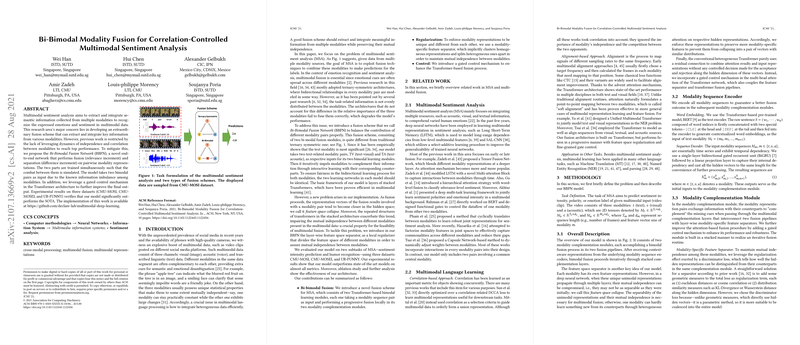Bi-Bimodal Modality Fusion for Correlation-Controlled Multimodal Sentiment Analysis
The paper "Bi-Bimodal Modality Fusion for Correlation-Controlled Multimodal Sentiment Analysis" presents an innovative approach to handling the challenges associated with multimodal sentiment analysis (MSA) by introducing the Bi-Bimodal Fusion Network (BBFN). This paper seeks to address limitations in previous work by incorporating a novel fusion scheme that enhances performance by dynamically balancing independence and correlation among modalities in the fusion process.
Methodological Contributions
The BBFN introduces a distinct fusion approach, focusing on pairwise modality interactions rather than traditional ternary combinations, which often led to information imbalance. By selecting text-focused modality pairs—specifically text-visual (TV) and text-acoustic (TA)—the BBFN maximizes the relevance of the text modality, which empirical studies have shown to be the most informative in MSA tasks. The BBFN iteratively enhances feature integration between modality pairs, supported by a gated control mechanism integrated into a Transformer-based architecture, augmenting the output effectiveness.
To prevent "feature space collapse," where representation vectors converge undesirably during fusion, the paper introduces the layer-wise feature space separator. This mechanism preserves the intrinsic independence between modalities, ensuring that each retains unique statistical properties throughout the fusion layers.
Experimental Results
Quantitative evaluation on datasets such as CMU-MOSI, CMU-MOSEI, and UR-FUNNY demonstrated that BBFN surpasses existing state-of-the-art (SOTA) models in most metrics. Notably, on CMU-MOSEI, BBFN achieved significant improvements in binary classification and mean absolute error, with over 4% enhancement in the latter. These robust results validate the efficacy of the BBFN in handling complex multimodal data.
Analysis and Implications
The comprehensive evaluation includes an ablation paper that examines the influence of BBFN's components, reaffirming the pivotal role of gating mechanisms and feature separation in enhancing model performance. The authors explore variations where different modality combinations are tested, providing evidence of the architectural versatility and the necessity of specialization in combining modalities.
There is a balanced assessment of gating weights, which suggests that BBFN can control information flow adaptively, aligning with the relative importance of each input modality's contribution. This dynamic approach suggests broader applicability and adaptability across various contexts of multimodal interaction beyond sentiment analysis.
Conclusions and Future Directions
BBFN offers a structured methodology for addressing the nuanced needs of multimodal sentiment analysis, offering enhancements in both practical application and theoretical understanding of modality interactions. The integration of specific mechanisms such as the feature separator and gated control opens avenues for further exploration in tasks requiring multi-faceted data interpretation.
Future research may focus on extending these methodologies to other multimodal tasks beyond sentiment analysis, optimizing the trade-offs between information richness and redundancy. Additional exploration into task-specific fusion strategies and their coordination with task-solving modules will likely yield further advancements in AI-driven fusion technologies.
